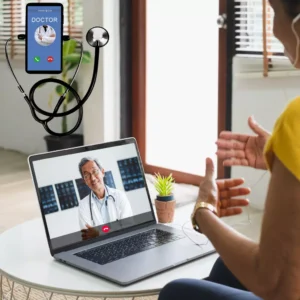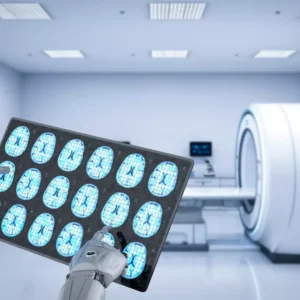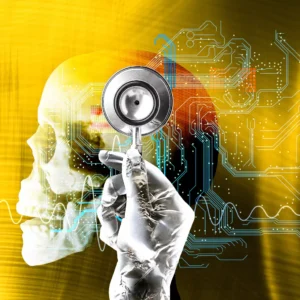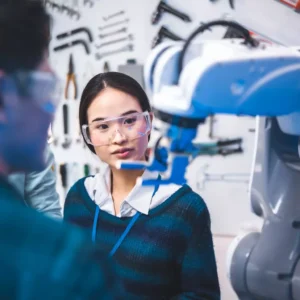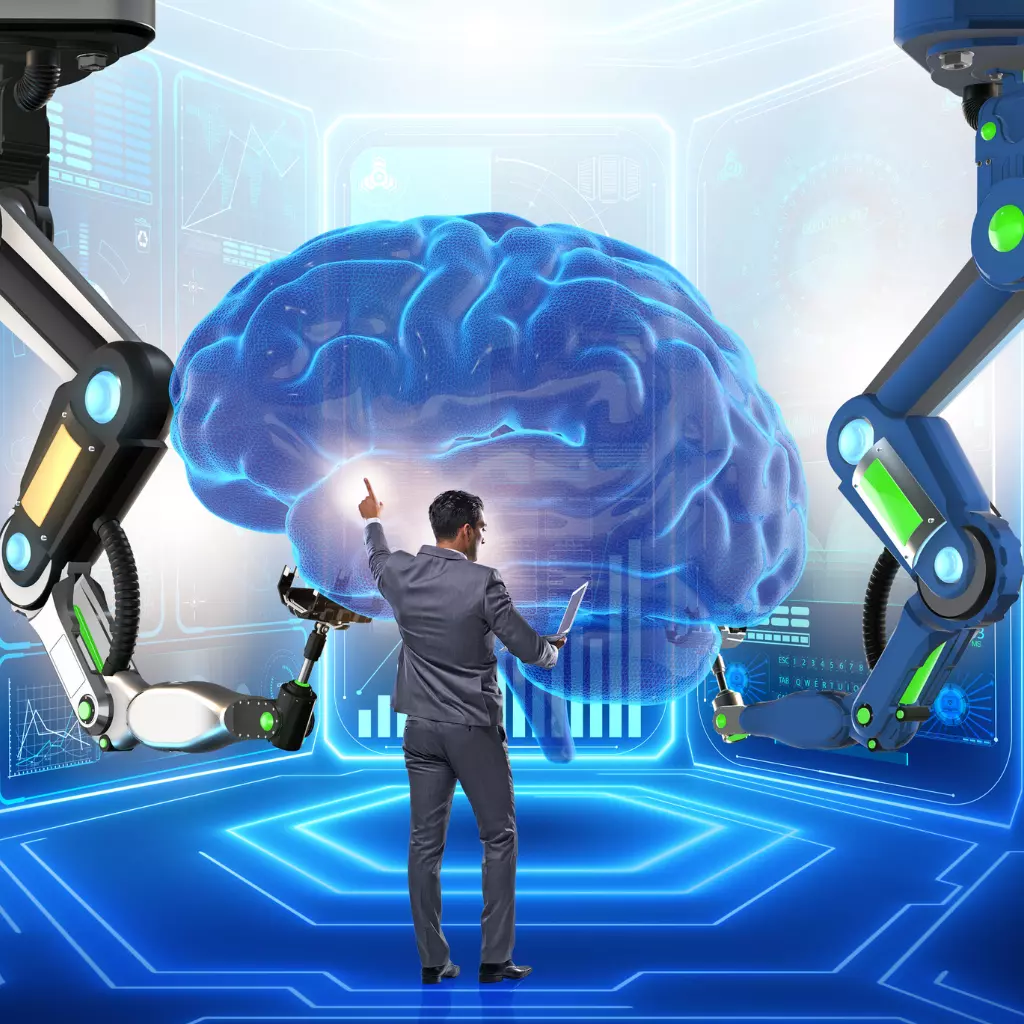
Medical Robots Enhanced by AI
Transforming Surgeries and Care
Medical robots, once a concept confined to science fiction, have become integral to today’s healthcare industry. Are you ready for a medical revolution? The future is here, called “Medical Robots Enhanced by AI.”
This isn’t just a buzzword; it’s a game-changer that will transform surgeries, patient care, and older adults companionship. Imagine being able to receive the most precise and optimized surgical care possible, with postoperative care that is second to none.
And if you’re an older adult looking for companionship, these robots are just what you need. Get ready to experience a world of possibilities with the power of AI and medical robots. It’s not the future—it’s the present.
This article delves into the history of medical robots, AI’s significant role in enhancing robotic precision, and the multitude of ways they’re transforming healthcare. We’ll cover everything from training the next generation of surgeons to evaluating the ethical and economic considerations.
Stay with us as we journey through the fascinating realm of medical robotics and get a glimpse into the future possibilities. Welcome to the world of AI-driven medical marvels!
Table of Contents

Arindam Roy
An Automation Consultant with 25+ years of IT Experience
Forbes Articles related to AI usage in Healthcare:
History of Medical Robots
In the 1980s, the first whispers of medical robots began. These machines, albeit rudimentary, hinted at a future where robotics would play a crucial role in healthcare. The earliest versions were primarily used to assist with surgeries and deliver precise interventions, reducing human error.
Fast forward to the 21st century, and the landscape of medical robotics has dramatically transformed. With the advent of sophisticated technology and intricate algorithms, Medical Robots Enhanced by AI took centre stage. These advanced robots assisted surgeons and began providing postoperative care and rehabilitation support.
One of the groundbreaking moments was the introduction of the da Vinci Surgical System, which allowed surgeons to perform minimally invasive surgeries with unmatched precision. As AI-driven precision in surgeries grew, so did the trust and reliance on these robotic aids.
Today, we stand at the crossroads of innovation and tradition. Once considered mere assistants, robots are now partners in healthcare, revolutionizing how care is provided. From robotic surgery advancements to robot-assisted rehabilitation, the journey of medical robots reflects the continuous endeavour to enhance patient care through technology.
How AI Enhances Robotic Precision
Robotic precision has been a game-changer in the medical world. With the initial use of robots, surgeons could carry out intricate procedures with more steadiness than the human hand. However, with the incorporation of AI, the concept of Medical Robots Enhanced by AI came into the limelight, pushing boundaries and elevating precision to unprecedented levels.
The integration of AI allows these robots to process vast amounts of data in real time. This ability translates to understanding minute details of a patient’s anatomy, thus enabling AI-driven precision in surgeries. For instance, while a surgeon’s hand might tremble, an AI-enhanced robot can adjust in microseconds, ensuring steadiness.
Moreover, these robots can learn from previous surgeries, identifying patterns and refining techniques. This learning capability is a hallmark of robotic surgery advancements, ensuring each procedure is better than the last.
The combination of AI’s data processing and the mechanical prowess of robots results in unmatched precision. As we move forward, the synergy between AI and robotics is set to redefine medical procedures further. The promise of enhanced patient safety, reduced recovery times, and minimal invasiveness underpins the significant strides in this field.
Rehabilitation and Recovery with Robots
Rehabilitation plays a pivotal role in patient recovery. Traditionally, physical therapists and medical professionals were solely responsible for this phase. Enter the era of Medical Robots Enhanced by AI and the landscape of postoperative care and rehabilitation is reshaped.
With robot-assisted rehabilitation, patients benefit from personalized therapy plans. AI-driven robots analyze a patient’s progress in real-time, adjusting exercises to maximize recovery benefits. This dynamic adaptation ensures that patients receive the right amount of challenge and support, hastening their journey to full recovery.
Additionally, for those requiring prolonged rehabilitation, robots offer consistency. They’re tireless, providing repetitive, precise movements often essential for muscle memory and strength rebuilding. This precision and repeatability, hallmarks of robotic surgery advancements, now extend to postoperative care.
One must recognize the psychological aspect, too. Interacting with robots can reduce the monotony of rehabilitation exercises, making the process more engaging for patients. These interactions, often overlooked, can significantly boost patient morale and motivation.
Integrating AI in rehabilitation robots is not just a technological marvel but a testament to how patient care and recovery are continuously evolving. The future holds promise, with robots set to play an even more integral role in personalized, efficient rehabilitation.
Older Adults Care and Robotic Companions
The golden years of life bring with them unique challenges. As the global Older Adults population rises, the demand for consistent and compassionate care has never been more pronounced. Medical Robots Enhanced by AI have emerged as potential game-changers in this scenario.
Robotics in Older Adults care has seen a surge in recent years. These AI-driven robots are not just about offering medical support; they’re about companionship. With the ability to learn and adapt, these robotic companions can cater to the emotional needs of older people, offering conversation, reminders, and even detecting signs of distress.
Another breakthrough is the robot’s ability to assist with daily tasks. Whether medication reminders, mobility assistance, or even simple chores, these robots ensure the older adult can maintain a semblance of independence. Such AI-driven precision in care ensures that older people lead dignified lives while minimizing risks.
Moreover, the interaction with robotic companions can also combat feelings of loneliness and isolation prevalent in this age group. Having a constant, non-judgmental companion offers solace to many.
In conclusion, as we navigate the challenges of an ageing population, robots enhanced by AI are proving invaluable allies. They are not just caregivers, they are companions, ensuring older people are cared for, both physically and emotionally.
Training the Next Generation of Surgeons
The medical world is ever-evolving, and as Medical Robots Enhanced by AI become an integral part of surgeries, the upcoming surgeons must be adept at harnessing this technology.
The initial stages of medical education traditionally focused on hands-on experience and apprenticeship. However, introducing robotic surgery advancements has led to a paradigm shift. Now, trainee surgeons are trained in simulations, enabling them to practice surgeries in a risk-free environment. These simulations, powered by AI, offer real-time feedback, ensuring that mistakes are corrected instantly.
Furthermore, training surgeons for robotic surgeries is more than just handling the technology. It’s about understanding the data and insights the AI offers, interpreting them, and making informed decisions. This holistic approach ensures that when they do perform on an actual patient, the outcomes are optimal.
Additionally, the continuous learning aspect of AI means that even seasoned surgeons benefit. They can keep abreast of the latest techniques, refine their skills, and learn from a vast database of past surgeries.
Patient Interactions with Medical Robots
The healthcare journey is deeply personal and filled with emotions, anxieties, and hopes. As Medical Robots Enhanced by AI make their presence felt, the nature of patient interactions transforms.
Initially, there were reservations. No matter how advanced, the idea of a robot participating in something as intimate as a surgical procedure or postoperative care was daunting for many. However, as robotic surgery advancements showcased their efficiency, these apprehensions faded.
Today, patients are not just interacting but actively engaging with these robots. Whether it’s the robot assisting a surgeon, aiding in rehabilitation, or even offering companionship in Older Adults care, patients are experiencing a new dimension of care. The patient experience with AI robots has shown that these machines provide consistency, precision, and tireless support, highly appreciated attributes.
Moreover, AI’s capability to offer personalized feedback, track recovery, and predict potential complications has added a layer of trust. Patients feel more informed, empowered, and in control of their health journey.
In conclusion, while human touch and empathy remain irreplaceable, AI-powered robots are carving a niche. They’re not just assistants but partners in care, ensuring patients receive the best of both worlds.
The Ethics and Responsibility
As the realm of Medical Robots Enhanced by AI expands, it brings crucial questions about ethics and responsibility to the fore. Blending machines and medicine isn’t just a technological marvel; it’s a matter of moral significance.
At the heart of robotic surgery advancements is the patient’s well-being. While robots offer precision and consistency, human professionals are responsible for decisions and outcomes. AI can provide insights, but the final call must always be human-centric. This emphasizes the importance of training surgeons for robotic surgeries, ensuring they can effectively collaborate with AI while prioritizing patient care.
Another critical concern is data privacy. With AI processing vast amounts of patient data, how is this information safeguarded? The ethical implications of medical robots extend to ensuring data protection, transparency in how data is used, and maintaining patient confidentiality.
Lastly, there’s the matter of dependence. While robots are invaluable aids, over-reliance on technology could lead to potential risks. Striking a balance between human intuition and AI-driven insights is vital.
In conclusion, as we stand on the cusp of a new era in healthcare, the convergence of ethics and technology is paramount. Our collective responsibility is to ensure that patient care remains at the forefront, even as we harness the power of AI.
Economic Considerations
The rise of Medical Robots Enhanced by AI is undeniably transforming healthcare. But as with all advancements, economic implications need thorough deliberation.
Initial investments in AI-powered robots are substantial. The cutting-edge technology that underpins these robotic surgery advancements comes at a price. Hospitals and medical institutions must evaluate the cost-benefit ratio, ensuring these investments translate to enhanced patient care and operational efficiencies.
However, the silver lining is the long-term savings. With AI-driven surgery precision, the likelihood of complications is reduced, leading to shorter hospital stays and fewer readmissions. Additionally, robot-assisted rehabilitation can expedite recovery, translating to reduced care costs.
Moreover, there’s the potential for increased surgical capacities. With their tireless work ethic, robots can assist in more surgeries than their human counterpart. This could mean more revenue for medical facilities, balancing out the initial expenditure.
Yet, the cost implications of AI robotics aren’t just about the financials. It’s about accessibility. Ensuring these advancements are not limited to elite institutions but are available widely, providing equitable healthcare for all.
In conclusion, while the economic considerations are multifaceted, the overarching goal remains clear: leveraging technology to offer superior, affordable, and widespread patient care.
Case Study: Successful Robotic Surgery
In 2022, a groundbreaking surgical procedure caught the world’s attention at the renowned St. Luke’s Medical Centre. It wasn’t just the complexity of the surgery but the means – a state-of-the-art Medical Robot Enhanced by AI.
Jane Doe, a 45-year-old patient, presented with a rare cardiac anomaly. Traditional surgery posed high risks, given the location of the monster. Enter the AI-enhanced robot with its promise of unmatched precision. The robot’s AI-driven surgery precision allowed for micro-movements, accessing areas that human hands might find challenging.
The robot analyzed countless similar procedures in pre-surgery using its AI capabilities, predicting potential challenges and determining optimal approaches. It provided real-time feedback to the surgical team during the surgery, ensuring every move was calculated and precise.
The result? A successful surgery, reduced operative time, and a swift recovery for Jane. In this case, the patient experience with AI robots was overwhelmingly positive, showcasing the immense potential of such collaborations.
This case exemplifies the potential of robotic surgery, providing a glimpse into the future of healthcare where man and machine work in tandem to offer hope and healing to countless individuals.
Future Possibilities
The horizon of healthcare is expanding, and leading the charge, does AI enhance Medical Robots. As we gaze into the future, the possibilities seem limitless.
Imagine a world where remote surgeries are the norm. With advancements in robotics and AI, surgeons could operate on patients from halfway across the globe. The future trends in AI and robotics point towards a reality where geographical boundaries are irrelevant to accessing quality healthcare.
Next, consider personalized care robots for older people. Beyond assisting in daily tasks, these robots could monitor health in real-time, predict potential health crises, and even offer companionship. Robotics in Older Adults care could redefine the golden years, ensuring safety, health, and happiness.
Furthermore, as AI continues to learn and evolve, we might witness robots assisting in medical research. Analyzing vast datasets, predicting the efficacy of drugs, or even proposing potential cures for ailments that have long eluded us.
Lastly, ethical considerations will also evolve. As robots become integral to healthcare, regulations and guidelines will be established to ensure patient safety, data privacy, and equitable access.
In essence, the convergence of robotic surgery advancements and AI paints a future of healthcare that’s efficient, accessible, and personalized. A promising future, indeed!
Conclusion
In the dynamic world of healthcare, the integration of Medical Robots Enhanced by AI heralds a transformative era. The strides made in robotic surgery advancements offer unparalleled precision, turning complex procedures into routine ones. Beyond surgeries, AI in postoperative care robots ensures patients receive consistent and personalized attention, accelerating their recovery.
The realms of robot-assisted rehabilitation and robotics in Older Adults care have witnessed innovations that prioritize patient comfort and well-being. These advancements also underline the importance of training surgeons for robotic surgeries, ensuring they’re adept at harnessing the power of technology.
As with any innovation, the patient experience with AI robots has been evolving, with many now viewing these robots as partners in their healthcare journey. However, the ethical implications of medical robots and the cost implications of AI robotics necessitate careful consideration and deliberation.
Yet, with every successful case study, the potential and promise of this technology are reinforced. As we look ahead, the future trends in AI and robotics in healthcare are brimming with possibilities, promising better care, increased accessibility, and improved patient outcomes. Indeed, the fusion of AI and robotics is not just reshaping healthcare; it’s redefining it.
Related Articles
- AI in Telehealth: Revolutionizing Remote Care
- Navigating the Next: AI’s Role in Healthcare Predictive Analytics
- Transforming Medical Imaging with AI Capabilities in Radiology
- AI in Genetic Data Analysis: Personalizing Medicine
- AI in Diagnostics: A New Era of Precision and Accuracy
- Smart Hospitals: The Role of AI in hospital operations
- Mental Health Tech: AI-powered Mental Health Apps for Assessment and Therapy
- AI-Powered Drug Discovery: A Revolution in Pharma
- Medical Robots Enhanced by AI: Transforming Surgeries and Care
- Wearable Health Tech: AI-driven health wearables
- AI’s role in chronic disease management
- Neural Interfaces and AI: Bridging Minds and Machines
- Digital Health Platforms: The Power of AI Integration
- AI in Epidemiology: Predicting and Controlling Outbreaks
- AI in Rehabilitation: Personalized Recovery Pathways
- AI in Predictive and Preventive Care: A Proactive Approach
- AI in Home Healthcare: Personal Health Management
- Revolutionise Healthcare with IPA Tools: Streamlining Processes, Improving Efficiency, and Enhancing Patient Care
- Other Articles on AI Usage in Healthcare
- Other Articles on AI usage in different industries

